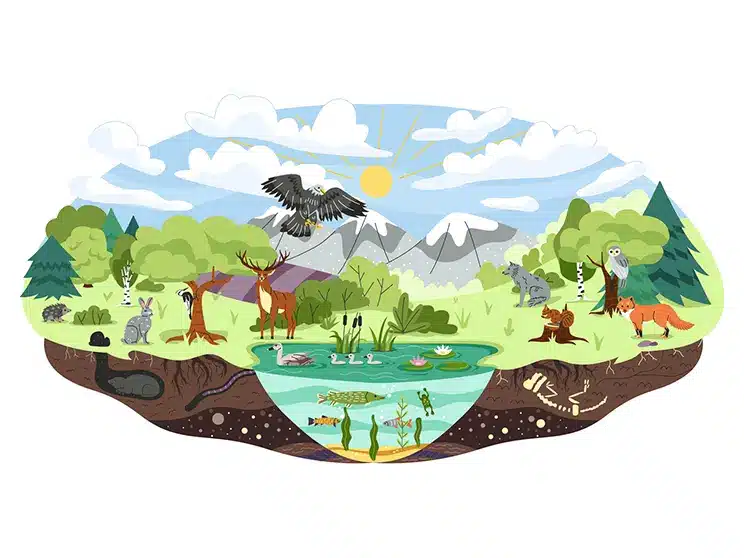What is Environmental Science? Learn About its Different Types!
Published: November 15, 2023

As the world keeps changing, more and more students are shifting their focus to think about the future of their planet. And for a majority, this means exploring the field of environmental science. If applying the principles of math and natural sciences to study the nature of life on Earth sounds like something that would pique your interest, then pursuing a career in Environmental Science or related disciplines of environmental health, environmental physics, or environmental chemistry may be the best fit for you.
Earning an environmental science degree can open up a myriad of possibilities right after college. You will leave school with fundamental skills and knowledge that will land you top-earning jobs in areas such as environmental research, education, sustainability, environmental impact assessment, and conservation, to mention a few.

Types of Environmental Science
Before taking a deep dive into the different types of environmental science, it is important to understand the field of environmental science independently. Environmental science is an academic field that studies the relationships and interconnectedness between the planet, its water, air, and life. In addition, it examines human beings’ impacts on the four factors and aims to solve problems such as climate change and the extinction of plant and animal species. Here are the different types of environmental science you should know about:
1. Ecology
This is the study of the interaction between living organisms on Earth. Ecologists study how animals, human beings, and plants are influenced by their environment and vice versa. Because ecology is an interdisciplinary field, it can include other broad disciplines such as biology, chemistry, physics, and geology.
2. Environmental Chemistry
This field studies the interaction of chemicals with water, air, soil, and living organisms. Popular sub-fields of environmental science include toxicology, atmospheric chemistry, and water chemistry. If you decide to pursue environmental chemistry, your course will consist of classes and lots of lab work in general, physical, analytical, and organic chemistry.
3. Atmospheric Sciences
This field primarily explores climate change and its impacts. It is the study of the Earth’s atmosphere and its relationship with the environment. You will learn how to create specific models showing how the atmosphere circulates, its reaction with various chemicals, and how animals and humans contribute to carbon (IV) oxide emissions.
4. Geosciences
Also known as earth sciences, the field of geoscience integrates all scientific disciplines that deal with Earth directly, such as environment soil science and geology, to mention a few. Geosciences study the physical and chemical makeup of Earth and its atmosphere. The main branches include the biosphere, lithosphere, hydrosphere, and atmosphere.
The Major Components of the Environment
The environment comprises five main components, namely:
1. The Hydrosphere
The hydrosphere constitutes all the waters on, under, or above the Earth’s surface. It is associated with water in liquid form, which covers an average of 70% of the Earth’s surface. The Earth only has a small portion of fresh water in groundwater, lakes, and rivers.
2. Lithosphere
Commonly known as solid Earth, the lithosphere forms the section of the outer part of the Earth inhabited by humans and from which they derive their minerals, food, and fuels. It is made up of the crust and the upper mantle. Soil is the most valuable part of the lithosphere because it is where all plants grow and where terrestrial organisms depend on it for their existence.
3. Atmosphere
The atmosphere comprises a mixture of gases surrounding the Earth. It acts as a protective blanket without which life on Earth would not exist. In addition to shielding the Earth from harmful UV rays, it provides the air we breathe.
4. Biosphere
This is the only part of the Earth where life exists. Air, water, and soil combine to make life possible in this narrow zone. Therefore, it plays an important role in maintaining the ecosystem.
5. Anthrosphere
Also known as the technosphere, this is the section of the Earth created or modified by human beings for habitation and economic activities.

The Scope and Importance of Environmental Studies
The principles of environmental science are applicable in many areas of development. Environmental science has a broad scope because it covers many issues. The three main areas of applicability of environmental science include:
- The conservation of biodiversity and ecosystem
- The prevention and management of pollution
- The management of natural resources
The scope of environmental science in relation to career prospects is also fairly wide. Here are the significant career opportunities in this field:
- Consultancy
- Industries
- Green marketing
- Academics
- NGOs
- International agencies
- Governmental jobs
- Green Advocacy
Principles of Environmental Science
This section covers the core principles of environmental science. Understanding how the ecosystem works is crucial because it is the only way we can solve our environmental problems. In light of this, here are the fundamental principles of environmental science:
Resource principles. Resources require long-term planning to achieve the goals of sustainable development. Conservation of natural resources is an efficient way of caring for resources while deriving maximum benefits from them.
Wildlife protection principles. The various types of wildlife have many aesthetic, biological, and economic advantages. Protected wilderness areas are essential in preventing wildlife extinction because they protect their natural habitat.
Soil principles. To ensure the survival of life on Earth, the protection of soils and the practice of sustainable agriculture are most important. Soil erosion cannot be reversed, so we should adopt different measures to conserve vegetation cover.
Environmental management principles. Sound environmental management is beneficial to both man and the environment.
Aims of Environmental Science Studies
Currently, the world is facing numerous challenges, ranging from the depletion of natural resources to climate change. These issues can only be solved when every person takes it upon themselves to care for the environment, and they can only do this with proper education. The importance of environmental science can be understood by its various aims and objectives, which include:
- Creation of awareness. This is fundamental to understanding. You cannot solve a problem you do not understand. Therefore, one of environmental science’s aims is to make the learner aware of the issues at hand and understand the various causes of environmental degradation.
- Transfer of knowledge. Education is a human right. Environmental science studies seek to educate learners about the environment and its different components.
- Inspiring a change of attitude. Knowledge will be useless if people are not driven to take the required steps to protect the environment. Therefore, environmental science seeks to help individuals develop a positive attitude toward safeguarding nature.
- Skill building. Environmental science seeks to help students develop impartial skills that will guide them to find solutions to existing environmental problems.
- Participation. Environmental science encourages learners to participate in activities to protect the environment. In addition, the overall objective is to add more people to the decision-making table to help resolve environmental issues.
